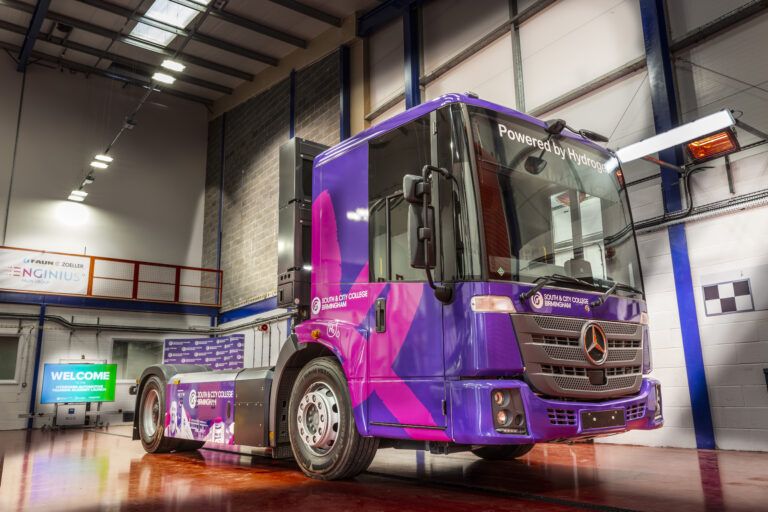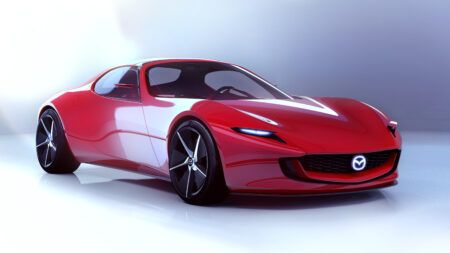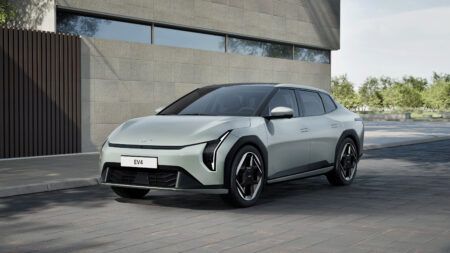Even though eHGVs have reached the market first, manufacturers are still exploring FCEVs options. Is there enough space for both technologies?
The challenge of decarbonizing road freight and municipal vehicles is one entwined with economic consequences, access to reliable infrastructure and the requirements of a vast array of applications that cannot be solved with a one-size-fits-all solution. As impending deadlines for vehicle decarbonization loom, all seven major European truck manufacturers have introduced electric versions of existing models. With existing infrastructure and clear government support in some countries, eHGVs have reached the market quicker than hydrogen fuel cell electric vehicle (FCEV) trucks or hydrogen internal combustion engine (ICE) options. While truck manufacturers are still exploring hydrogen powertrains, eHGVs are able to offer zero-emission solutions immediately.
Mark Collins, E-Mobility and Body Builder Product Manager at Volvo Group, underlined the difficulty of finding a suitable solution for trucks compared to other vehicles. “Where electric passenger cars and most vans draw energy from the batteries to predominantly power the drivetrain, a lot of lorries require the energy to power the auxiliary equipment. Therefore, the energy throughput could be significant in relation to the mileage. A mixer or a crane vehicle, for example, could be on site drawing power over a long period of time before moving.”
Despite hydrogen technology being in its infancy compared to EVs, FAUN Zoeller has pushed ahead with its FCEVs for municipal and regional distribution applications. Under the Enginius sub-brand, which is dedicated to alternative fuels, the company offers Bluepower and Citypower models with FCEV powertrains.
Both models use Mercedes-Benz chassis, Bluepower borrows the Econic while Citypower has an Atego chassis. Bluepower has three 30kW fuel cells, an 85kWh battery and storage for up to 16.4kg of hydrogen gas at 700bar. Using a 4×2 chassis, a payload of up to 12-tonne can be achieved with a range of 250km. A 6×2 chassis offers the same range and payload up to 18-tonne.
Powertrain packaging
Regardless of whether FCEV or BEV technology will be the prevailing choice in the future, both present challenges and significant benefits, some of which are shared across the fuel types. In municipal and urban environments, maneuverability is an important characteristic to maintain. As a result, manufacturers are challenged with packaging bulkier powertrain components into short wheelbases.
“We try to work within the shortest wheelbase we can,” said David Graham, Head of Engineering at FAUN Zoeller, “And often use 3.9m wheelbases.” Instead of positioning hydrogen tanks between the cab and body, FAUN Zoeller mounts them between the chassis rails to keep overall vehicle length to a minimum. This configuration also provides flexibility for different bodies to be added depending on the application.
Next to space restrictions are weight limits with manufacturers juggling range capabilities, payload capacity and regulations. “For lorries, the volumetric density of batteries is the most important characteristic, due to constraints on vehicle size,” said Collins. “So, whilst batteries are being developed continuously, other components are also being developed to free up space for the additional packs, such as e-axles.”
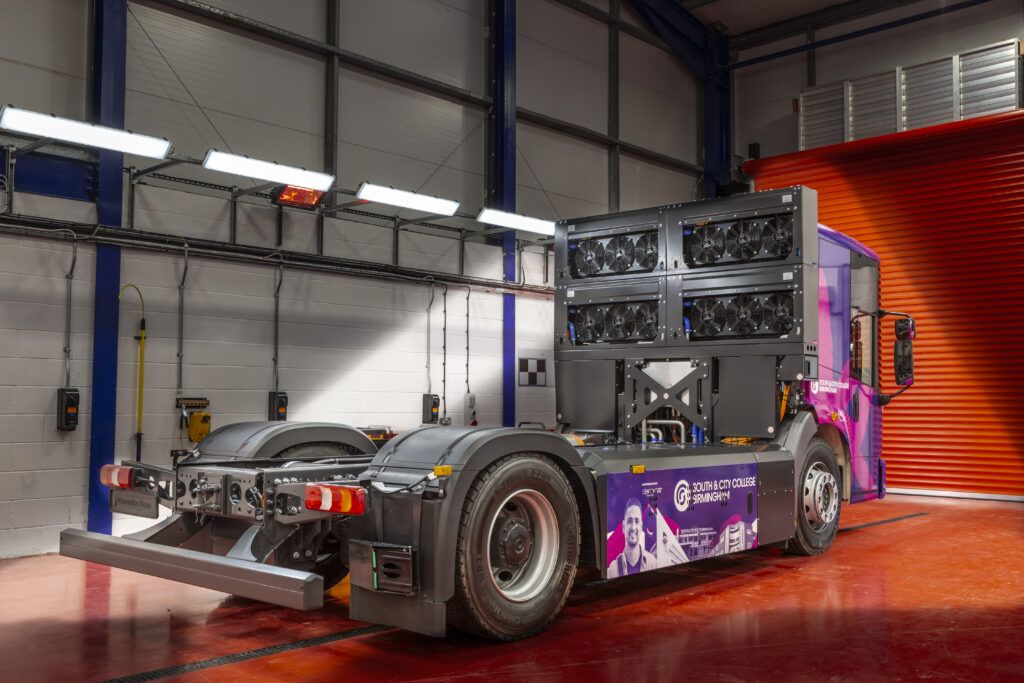
Power take-offs
Crucially, for the success of alternatively fueled trucks that operate auxiliary equipment, such as concrete mixers, cranes, skiploaders and refuse collection, vehicles must be fitted with the appropriate power take-off units. For trucks that require high levels of power, like concrete mixers, Volvo uses an electro-mechanical PTO to connect with hydraulic systems. “This is a motor that was selected due to the fact that it can operate independent of the vehicle’s driveline so that it can power the hydraulic system for the mixer drum both when the vehicle is stationary and on the move,” said Collins. “As well as this, the PTO can also be activated when the vehicle is charging on AC or DC power. This is more versatile and energy-efficient than a gearbox PTO and can be used to power many other applications such as refuse collectors, tippers, cranes etc.”
When it comes to efficiency, Collins sees improvements can be achieved with electric PTOs. “We can specify vehicles with a direct electric PTO which can currently provide up to around 40kW of power, ideal for lower-power applications like refrigeration units, which require peak power of around 15kW, but may not quite be enough power for an 8m3 cement drum during the loading/unloading phase, which could require up to around 50kW,” he said. “Future improvements in vehicle technology will allow for a more powerful direct electric PTO to be used in the future, which could eliminate the need for hydraulics, hence reduce the number of moving parts and improve efficiency and range.”
Since FAUN Zoeller’s FCEVs are tailored to regional and municipal applications, the company fits electric PTOs for the greatest efficiency. Graham also anticipates the electric PTO will be the favored solution moving forward.
Thermal management
With an electro-mechanical PTO fitted, additional cooling is required but elsewhere the cooling system in an electric truck is fairly conventional. “It consists of a closed circuit with three loops – the batteries, powertrain and cab heating – where each loop has a different temperature control with independent coolant pumps,” said Collins. “To minimize cab heating losses, there is additional insulation and laminated glass on the side windows and the vehicles have a ready-to-run feature to bring the cab environment and batteries up to operating temperature when still plugged in to the charger.”
The cooling system for FCEVs is slightly more complex with a cooling unit for high voltage equipment, and primary and secondary cooling systems for each fuel cell. “Roughly speaking, the output of a fuel cell is 50% power, 50% heat,” Graham said, “Each fuel cell has its own radiator system and the auxiliary equipment like motors and inverters have their own cooling system as well.”
The fuel cells use the non-conductive coolant glysantin. A FCEV’s cooling systems are the most complex part of the powertrain, so regular maintenance inspections focus on ensuring the systems are working as they should with the correct coolant levels.
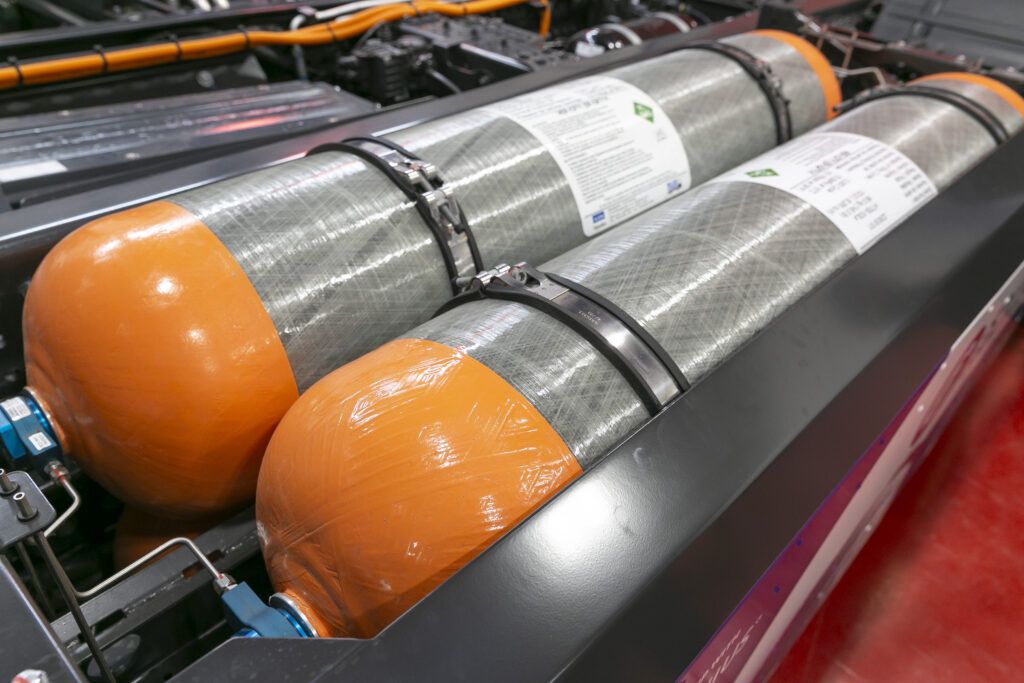
Technology to facilitate change
In this transitionary period to alternative fuels, software surrounding the vehicle is equally as important as software controlling its functions. To determine customer power usage, FAUN Zoeller installs hardware on a customer’s existing vehicle to gather data about their typical routes. Using an algorithm which considers factors such as speed, fuel usage, payload and driver behavior, the company can calculate a customer’s power requirements.
“We’ve got thousands of data reports so we know that municipal vehicles will typically do 60 to 70 miles a day and lift 1,200 bins,” said Graham. “These data loggers are a tool that we can put onto customer vehicles before they buy a vehicle to make sure that the vehicle will give them what they need out of it.” Once vehicles are deployed, these data loggers act as diagnostic tools to monitor and identify any issues, minimizing downtime.
At Volvo, simulation technology is employed to work out the best vehicle specification for a customer’s needs. “Moving to EVs where range and efficiency is even more in-focus has provided a platform to review and optimize solutions through pump selection to motor speed controlled via the CAN,” said Collins. “This information is always fed through the engineering team and can be used to input data into our in-house ‘Electric Range Simulator’ which can accurately programme routes, including various factors such as PTO usage, ambient outside temperature, road topography, vehicle payload, regeneration, all the way down to the level of detail of which tire rolling resistance class is specified to provide an output to determine whether the routes are possible or not, and ultimately how many batteries are required.”
Practical suitability for any application extends beyond merely completing the task itself. For manufacturers, much of the logistical arrangements for charging or refueling are out of their control. Hence, route planning and exploring the viability of these vehicles become a more important factor.
The main differences between eHGVs and FCEVs at this stage is price and refueling times. While a hydrogen vehicle can fill its tanks in under 10 minutes, electric vehicles rely on super-fast charging or overnight stints to prepare for the next workday. While eHGV deployment is accelerating more quickly, there’s likely to be a need for both technologies as well as other alternatives in the future.
“There are applications for fuel cell vehicles and applications for electric vehicles,” said Graham. “I think when it comes to refuse collection vehicles, it’s probably going to be 70% electric and 30% fuel cell in 10 years’ time.”
Hydrogen training facility
The deployment of any alternatively fueled vehicle relies on more than just the provision of the vehicle itself. Access to fueling, appropriate subsidies or funding options and a network of technicians to maintain the vehicle once it’s in operation are key components. South and City College Birmingham (SCCB), in collaboration with FAUN Zoeller UK has opened a new hydrogen training facility to upskill existing technicians and new mechanics in hydrogen technology.
Following a £1.5 million investment, SCCB unveiled a new 450m² ATEX-compliant workshop dedicated to working on hydrogen vehicles. Alongside passenger cars which students will be able work on, the college purchased an Enginius Bluepower FCEV. The facility, which is thought to be the first of its kind in Europe, will deliver Institute of the Motor Industry (IMI) Level 1 hydrogen vehicle awareness, IMI Level 2 hydrogen vehicle routine maintenance activities and IMI Level 3 hydrogen FCEV system repair and replacement courses. Higher level courses are also planned including the IMI Level 4 award in the diagnosis, testing and repair of electric/hybrid vehicles and components with hydrogen awareness.
Simon Hyde, CEO at FAUN Zoeller UK said, “The debate around alternative vehicle fuels has largely focused on electric power and hydrogen-sceptics have cited funding, fueling, performance and skills as barriers to adoption.
“We believe that none of these are insurmountable. With the launch of this training facility and the commitment that SCCB has demonstrated, the existing and future workforce will benefit from the most appropriate training to enable them to effectively service, maintain and carry out diagnostics on hydrogen-powered municipal vehicles.”
SCCB plans to open up its hydrogen training facility to students across its automotive courses to prepare them for jobs in the future that may involve maintaining hydrogen vehicles. FAUN Zoeller plans to train new UK-based technicians through the college as it expands its network of mobile engineers.

Alternative decarbonization options
While much of the focus rests on zero-emission solutions that are expected to replace diesel trucks, some truck manufacturers are exploring interim solutions to decarbonize fleets in the short-term. In hard to decarbonize sectors like construction, fleet operators are likely to need alternative fuel solutions in scenarios where infrastructure and working patterns are difficult to adapt for zero-emission powertrains.
“Zero-emission battery electric vehicles are just one technology which can provide benefits from an environmental perspective,” said Collins. “There are a range of other technologies and fuel-types which can also be used in different segments. For example, drop-in fuels that come from a renewable feedstock can replace EN590 diesel today which have a beneficial well-to-wheel CO2e saving.
“Alongside this, gas-powered vehicles that can run on biomethane can provide both CO2e savings at the tailpipe (tank to wheel) and well-to-wheel, again, when using a feedstock from a renewable source. These are solutions that can be adopted to decarbonize transport today alongside battery electric vehicles.”
These solutions require comparatively minimal cost investment from operators and manufacturers. Adapting existing equipment or finding fuels that can be used with no modifications to existing equipment is the most cost effective way to impact CO2 emissions before the price of EVs and FCEVs comes down.
